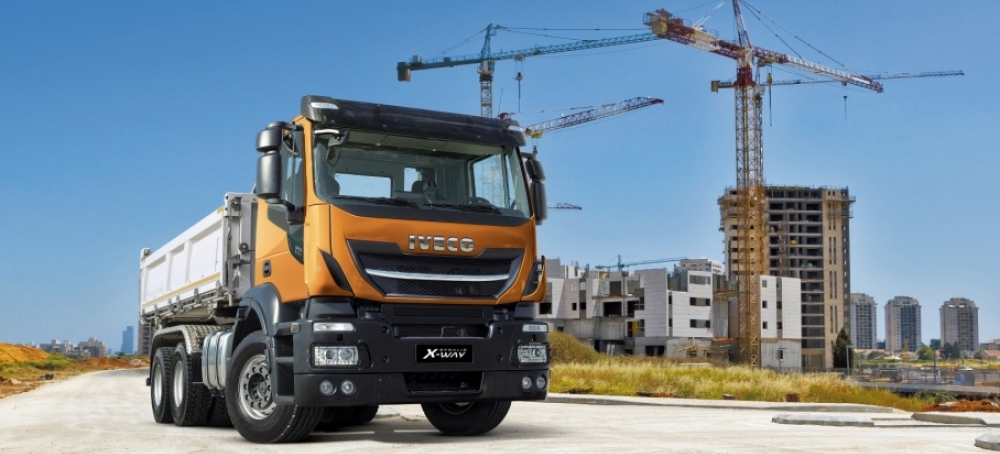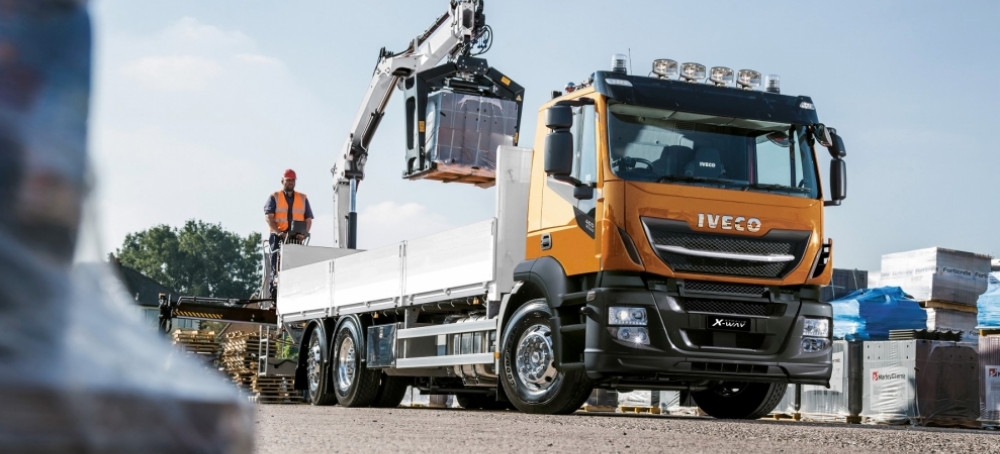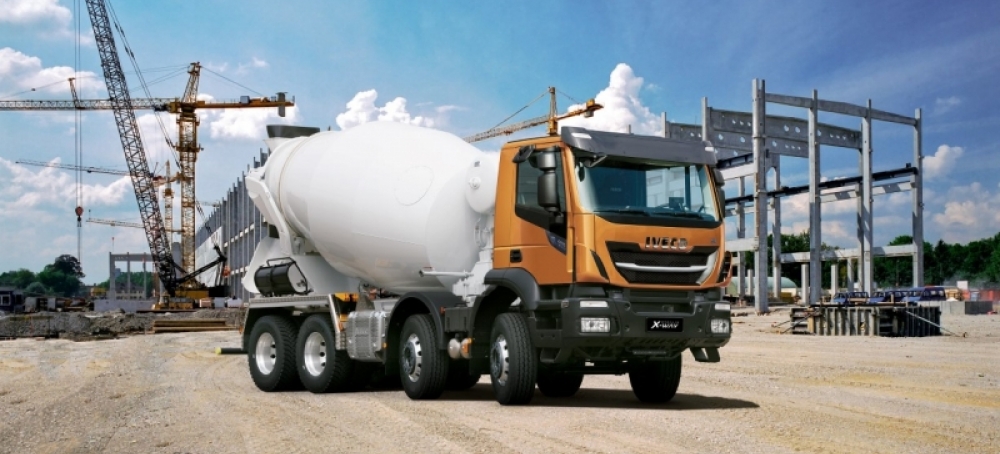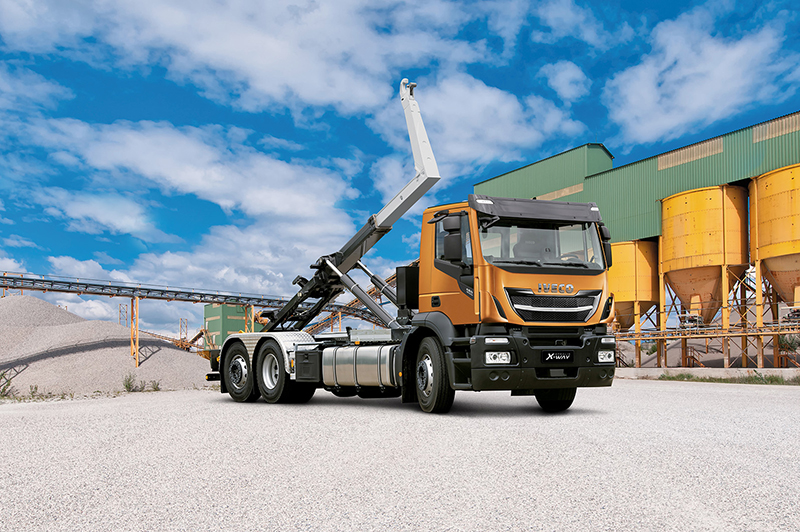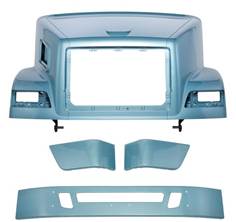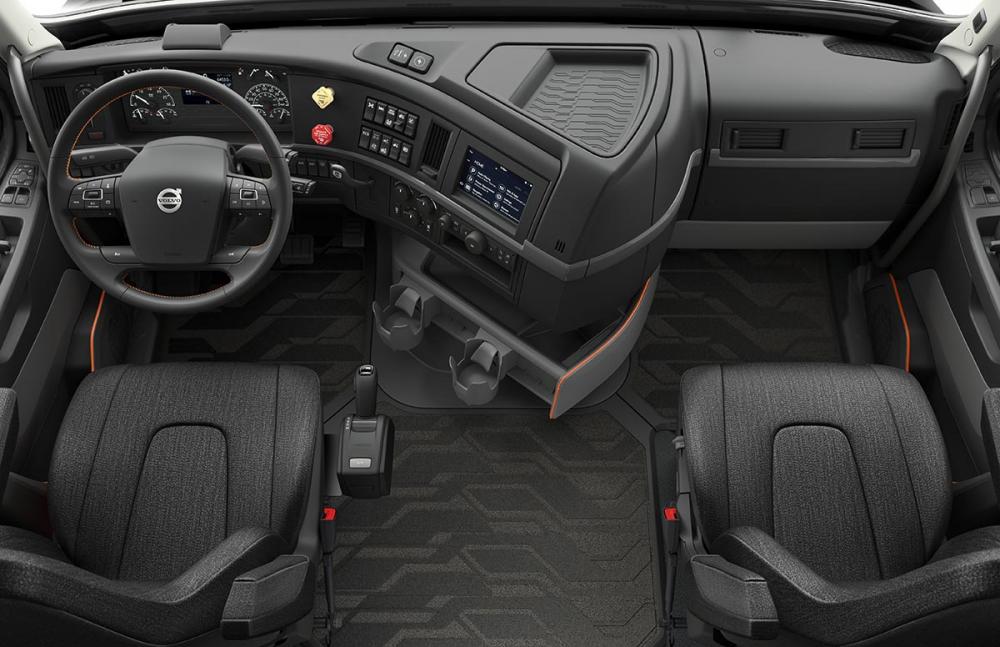
kscarbel2
Moderator-
Posts
17,893 -
Joined
-
Days Won
86
Content Type
Profiles
Forums
Gallery
Events
Blogs
BMT Wiki
Collections
Store
Everything posted by kscarbel2
-
IVECO Trucks Press Release / June 5, 2017 Best-in-class payload capacity and ultimate fuel efficiency technology. A completely new range for vocational and construction logistics missions extends IVECO’s wide offering: the Stralis X-WAY is perfect for on-road applications requiring light off-road mobility. IVECO previewed the new vehicle at its Madrid manufacturing plant during the ceremony for the award of the World Class Manufacturing Gold Medal. On Friday June 2nd at the IVECO plant in Madrid the World Class Manufacturing (WCM) Gold Medal award ceremony was held in the presence of Sergio Marchionne, Chairman of CNH Industrial, Richard Tobin, Chief Executive Officer of CNH Industrial and the CNH Industrial Board of Directors. This important event provided the opportunity to preview a brand new vehicle that will arrive in markets across Europe in September: IVECO is preparing to launch the Stralis X-WAY, a truck that raises the stakes in light off-road missions with the highest payload in its segment, combining the best of IVECO’s fuel efficiency and safety technologies with the brand’s most robust chassis design. Pierre Lahutte, IVECO Brand President, stated: “The Stralis X-WAY breaks new ground in missions that have very specific requirements. Designed for on-road applications and light off-road mobility, our new X-WAY combines the legendary Trakker chassis strength with all the fuel saving and safety features of the New Stralis. It offers all the performance and comfort benefits of our most advanced long haul on-road trucks like the latest XP, together with the robustness of our toughest off-road vehicle. With the X-WAY, our customers can have the confidence to tackle with ease the ‘last mile’ on the uneven and sometimes difficult conditions of jobsites when making their delivery. High productivity, safety and excellent TCO in light off-road missions: this is what our customers can expect from our brand new truck.” The Stralis X-WAY pushes the boundaries when it comes to its exceptionally low kerb weight. This, combined with the sturdy chassis, gives it the best payload capacity in the market in its category with its Super Loader (SL) version on an 8x4 chassis with a kerb weight as low as 9 tonnes – the lowest in the industry. The wide offering of high-efficiency engines, available with three displacements (9, 11 and 13 litres) ensures there is a solution to suit every mission – all of them delivering excellent fuel economy and a powerful performance. The Hi-SCR engine technology, with no EGR and no parked regeneration, dramatically cuts emissions and increases fuel efficiency, while lowering maintenance costs. It is particularly well suited to the vocational and construction logistics missions, which often happen in urban environments where the EGR systems are more penalized in terms of soot production. The absence of EGR – which lowers power density – also brings benefits in terms of payload, as it makes the vehicle lighter. The advanced technologies, long service intervals and durability of the on road Stralis X-WAY result in remarkable savings in maintenance and repairs. Disc brakes further cut down on costs due to the reduced wear and tear. Added to the exceptional fuel economy, this means excellent Total Cost of Ownership. The fuel reduction technologies include state-of-the-art systems such as HI-CRUISE and the SMART Auxiliaries that have achieved the 11.2% fuel reduction validated on the on-road XP truck by TÜV SÜD, one of the world’s leading technical service organizations. The modular, mission-oriented approach of the Stralis X-WAY provides ultimate flexibility in customising to the specific requirements of a wide variety of applications. It offers a choice of artic and rigid versions; different axles, suspensions, vehicle setups, engines and transmissions; Hi-Traction hydrostatic drive; a wide offer of engine and gearbox PTOs; and on- and off-road homologations. The wide choice of features and components, the structural strength, and low kerb weight result in a vehicle that can be configured for an extensive variety of missions. The Stralis X-WAY offers a choice of cabs: the AD (Active Day) short cab with low roof, AT (Active Time) sleeper cab with low or medium roof, and for ultimate comfort, AS (Active Space) Sleeper cab, which was designed around the driver for the long-haul missions of the New Stralis XP. Drivers will be just as comfortable and safe on the longer on-road sections of their missions and on the shorter off-road drives when collecting or delivering a load on a jobsite. The vehicle is manufactured in the IVECO Madrid plant, the first manufacturing facility of the CNH Industrial Group to have reached Gold Level in the World Class Manufacturing (WCM) program, one of the highest standards for the integrated management of manufacturing plants and processes. The Stralis X-WAY will be available through IVECO dealerships across Europe from September 2017. The international launch to the public will take place at the 14th edition of Solutrans, the urban and road transport solutions show, from 21 to 25 November, at Lyon Eurexpo. The Stralis X-WAY will compete for the prestigious “International Truck of the Year 2018” Award. .
-
Scania D14 Series Year Model Power 1969 DS14 01 350hp turbocharged, introduced 1969 at IAA 1971-1976 D14 260hp (normally aspirated for bus applications) 1981 DS14 06 388hp 1982 DSC14 01 420hp intercooled DSC14 02 390hp intercooled 1988 DSC14 06 404hp intercooled DSC14 03 450hp intercooled DSC14 04 470hp intercooled, Bosch EDC (Electronic Diesel Control) 1991 DSC14 10 453hp Euro-1, intercooled DSC14 09 500hp Euro-1, intercooled, Bosch EDC (Electronic Diesel Control) 1994 DSC14 16 500hp Euro-2, intercooled, Bosch EDC (Electronic Diesel Control) 1996 DSC14 15 460hp Euro-2, intercooled, Bosch EDC (Electronic Diesel Control) DSC14 13 530hp Euro-2, intercooled, Bosch EDC (Electronic Diesel Control) The current Scania Euro-6 DC16 V-8, in 520, 580 and 730 horsepower ratings, has a 16.4 liter displacement, identical to the Mack E9. (Mack Trucks jumped from 14.2 liters to 16.4. Scania moved incrementally from 14.2 to 15.6 to 16.4)
-
Springfield News-Sun / June 5, 2017 Navistar will lay off more than 80 workers at its Ohio Truck Specialty Center in Springfield beginning in early August, according to a notice the truck manufacturer filed with the Ohio Department of Job and Family Services. The layoffs are part of a plan to restructure the local workforce as the company ramps up hiring for a joint agreement with GM to build medium-duty trucks in Springfield, company officials said. The joint agreement included plans to create about 300 jobs, with Navistar beginning production of the medium-duty trucks at the Springfield plant next year. Navistar is one of Clark County’s largest employers, where it employs more than 1,500 workers. Thousands of retirees also remain in the area. Of the 81 workers being laid off, 78 are journeyman mechanics with the company. The remaining positions affected include one temporary full-time contractor and two Truck Specialty Center clerks. The move will allow Navistar to move work that was being done at its Truck Specialty Center back into the company’s main Springfield facility, said Lyndi McMillan, a spokeswoman for Navistar. The manufacturer also began production earlier this year on a cutaway model of GM’s G Van as part of a separate joint agreement. The two separate agreements with GM are expected to create a total of about 600 new jobs in Springfield, McMillan said. The workers being laid off will be able to apply for available positions in the main facility as Navistar ramps up hiring to begin production on the medium-duty trucks. However it’s not guaranteed they will all be hired at the main facility, she said. The notice, which was posted online Monday, indicated Navistar will permanently lay off 81 members of its United Auto Workers Local 402 and 684 unions. The affected workers aren’t covered under the main labor agreement with the UAW, and therefore don’t have transfer rights, McMillan said. That means they will need to reapply for other positions available at the main facility. The company reported a net loss of $62 million for the first quarter this year, citing continuing weak demand in the heavy truck industry. However company leaders also said they expected the market to rebound later this year. Navistar’s expected to post its second quarter results later this week. Of the mechanics, 36 of them will be let go during a 14-day period beginning on Aug. 1, according to the notice filed with the state. An additional 25 mechanics and one temporary full-time contractor will be laid off over a 14-day period beginning on Sept. 1. The company’s notice said 17 more journeyman mechanics and two Truck Specialty Center clerks will be permanently laid off over a 14-day period beginning on Sept. 29. Jason Barlow, president of the UAW Local 402, described the move as a business decision for the company. He said the 78 mechanics will be offered employment at the Springfield assembly plant as jobs become available. Barlow also said those workers will retain recall rights to the TSC mechanics unit and can return to the TSC if new work picks up in that unit. Marcia Flax, president of the UAW Local 658, didn’t return a call seeking comment. Navistar filed the notice as part of the Worker Adjustment and Retraining Notification Act, which requires employers to give officials notice of pending mass layoffs. No further information was included in the company’s notice. Amy Donahoe, director of hiring and employer services for the Greater Springfield Chamber of Commerce, said she was notified about the layoffs Monday but was unable to provide further information. She said local workforce development officials will deploy a rapid response team to provide information about unemployment compensation and other assistance for the impacted workers. By the numbers 81: Navistar workers to be laid off from the Springfield plant in August and September 1,500: Total workers at Navistar’s Springfield plant 600: New jobs Navistar will add in Springfield as part of two agreements to build vehicles with GM.
-
Navistar's stock rockets after analyst upgrade on belief results, truck industry on verge of a bottom Market Watch / June 5, 2017 Shares of Navistar International Corp. NAV, +12.82% ran up 9% in active midday trade Monday, after RW Baird turned bullish on the commercial and military truck and truck engine parts maker for the first time in at least 2 1/2 years. Analyst David Leiker raised his rating to outperform, after being at neutral since at least September 2014. "We believe Navistar is nearing the end of a half-decade transformation after a near-fatal decision to internally produce heavy-duty engines," Leiker wrote in a note to clients. "We believe the transformed Navistar is on the verge of driving higher volume, profit margins and earnings that could take the stock above $50 over the next several years." Leiker said the company's efforts have helped stabilize market share and have improved profitability, just as he expects truck industry volumes to bottom this year.
-
Freightliner introduces next-generation Cascadia
kscarbel2 replied to kscarbel2's topic in Trucking News
-
The first Mack FCD rail bus (serial number 1001), the one "Type 1" unit we built, was powered by a 200 horsepower supercharged ENDS-672 Mack-Lanova engine. https://www.bigmacktrucks.com/topic/39989-mack-rail-–-the-rail-cars/ https://www.bigmacktrucks.com/topic/33763-mack-rail-sperry-rail-service-the-oldest-operator-of-mack-rail-buses/ https://www.bigmacktrucks.com/topic/39495-update-sperry-rails-mack-fcd-rail-bus/
-
When you look at the build records of Mack trucks from the 1960s (on microfilm) and read where one box is checked for the supplier under possible engine options, you will see the name Allis-Chalmers (and Chrysler). https://www.bigmacktrucks.com/topic/30186-macks-powered-by-other-engine-manufacturers/
-
-
Buda diesel engines ranging from 3.5 to 7.7 litres (212 to 468 cu.in.), were available in Mack trucks, in addition to Cummins, from 1936. During the mid to late 1930s, Buda was a leader in diesel engines and very popular. Mack's first diesel, the 131 horsepower ED519 incorporating the Lanova combustion chamber design, was launched in 1938. Like Buda and others, Mack Trucks had purchased a technology license from Germany’s Lanova AG, led by the German engineer and Lanova concept inventor Franz Lang.
-
In 2004, Meritor and Daimler had signed a MOU. But it doesn’t appear to have endured. Back then, AAC was an axle buyer rather than a producer. -------------------------------------------------------------------------------- TROY, Michigan, (June 10, 2004) — ArvinMeritor announced today that it has signed a memorandum of understanding with Axle Alliance Co. (AAC), a subsidiary of Daimler Chrysler (DCX) headquartered in Detroit, Mich. Under the terms of the proposed long-term agreement, ArvinMeritor would become the turnkey supplier in providing heavy-duty tandem rear drive axles to AAC, ultimately for Freightliner’s North American Class 8 truck assembly operations. Implementation of this memorandum is subject to the execution of a definitive agreement. With this memorandum of understanding, ArvinMeritor will partner with AAC on the design, development and assembly of heavy-duty axles from ArvinMeritor facilities in York, S.C., Monterrey, Mexico, and Asheville, N.C. ArvinMeritor and AAC have had a cooperative working relationship for more than five years, together bridging the gap between American and European axle technologies. ArvinMeritor and AAC will continue to work together in a partnership to successfully support the DaimlerChrysler worldwide truck axle platform strategy. “ArvinMeritor will continue to produce its own axle designs for Freightliner, and under this announced memorandum of understanding, we will become the turnkey supplier of a new line of proprietary AAC tandem axles,” said Tom Gosnell, president of ArvinMeritor’s Commercial Vehicle Systems business group. “This incremental relationship for ArvinMeritor has opened the door for growth in our axle component supply business around the world. We’re geared up to become a much larger player, and welcome the opportunity to demonstrate our global competitiveness to DCX.” Christof Traidl, president and CEO of Axle Alliance Company, said, “Axle Alliance Company -- by partnering with ArvinMeritor -- is securing a competitive launch of our product. Using ArvinMeritor’s existing resources, we will avoid redundant asset implementation and merge best practice methods from the two major axle players in the world.” Rainer Schmueckle, Freightliner LLC President and CEO, said, “Freightliner is pleased to incorporate the new DaimlerChrysler proprietary axles which are available exclusively to customers of our truck, bus and chassis brands. Across the company’s brands and product lines, we offer a range of proprietary components including Mercedes-Benz medium- and heavy-duty engines and Mercedes-Benz manual and automated transmissions. Now the introduction of these new proprietary axles will provide exclusive performance benefits and value to our customers.” Axle Alliance Company, headquartered in Detroit, Mich., is a wholly owned subsidiary of DaimlerChrysler supplying front and medium-duty rear axles to Freightliner, Freightliner Custom Chassis, Thomas Built Bus, Sterling and Western Star. Bridging American and European technology, AAC is developing, producing and supplying innovative systems for the commercial truck market. AAC also provides consulting capabilities for automotive industries. https://www.meritor.com/ourcompany/news/Lists/News/DispForm.aspx?ID=1180&RootFolder=%2Fourcompany%2Fnews%2FLists%2FNews%2F2004
-
FMCSA Proposes Split Sleeper Berth Pilot Program
kscarbel2 replied to kscarbel2's topic in Trucking News
DOT announces pilot program to study split sleeper berth flexibility in hours of service regs James Jaillet, Commercial Carrier Journal (CCJ) / June 5, 2017 Following incremental steps toward such a study in recent years, the Federal Motor Carrier Safety Administration will formally announce Tuesday a pilot program intended to gauge the feasibility and safety aspects of adding split sleeper berth options to hours of service regulations. FMCSA says it seeks at least 200 drivers to participate in the study. Drivers will be studied for up to 90 days, per a Federal Register entry slated for publication June 6. Current regulations allow drivers, as an alternative to a straight 10-hour off-duty period, to take an eight-hour sleeper berth period to break up their 14-hour on-duty limit and their 11-hour drive-time limit. Drivers using this provision must take a two-hour off-duty period after exhausting their 11-hour drive-time limit. The two-hour off-duty period counts against drivers’ 14-hour limit for the on-duty period broken up by the two-hour break. The agency’s split sleeper berth pilot program seeks to determine the effects other split sleeper berth options, such as 5-5, 6-4 and 7-3, would have on drivers and their ability to operate. The study’s outcome could dictate whether FMCSA decides to pursue reforms to hours of service regulations pertaining to split sleeper berth flexibility. FMCSA said last year it had partnered with Virginia Tech’s Transportation Institute and Washington State University to conduct the split sleeper berth pilot program. Researchers will study the 200 (or more) drivers in their normal operations. However, drivers will be free to split their sleeper berth time into two segments of “any combination..totaling 10 hours.” “Drivers would be able to use split or consolidated sleep schedules as they choose,” the agency says, “but they still must meet the daily minimum rest requirements.” The study seeks to data from ELDs, monitoring systems like video recorders, roadside inspections, wrist actigraphy (studying total sleep time and wakefulness), psychomotor vigilance tests taken in cab, subjective sleepiness ratings as noted by drivers and sleep logs. Researchers will then study the data and make conclusions regarding the positive or negative outcomes of drivers using split sleeper berth options. FMCSA is soliciting carriers and drivers to participate. Those interested in participating should visit sleeperberthstudy.com to complete an application, take a questionnaire and provide written consent to be studied. The agency has not said how long the data collection phase will last in sum, only saying individual drivers will be studied for up to 90 days. It also did not say how long it would take to produce conclusions based on the data gathered. Public comments about the study are being accepted for 60 days, giving carriers and drivers the chance to provide the agency with input about the study and how it should proceed. The comment period opens Tuesday and will be available at the regulations.gov rulemaking portal via Docket No. FMCSA-2016-0260. -
Heavy Duty Trucking / June 5, 2017 Hoping to develop “statistically reliable evidence” on whether split-sleeper-berth time affects driver safety performance and fatigue, the Federal Motor Carrier Safety Administration is proposing a pilot program that would give a limited number of CDL holders temporary relief from the existing sleeper-berth regulation of the hours of service rule. During the pilot program, participating truckers who regularly use a sleeper berth to accumulate their required 10 hours of non-duty work status would have the option to split their sleeper berth time within parameters specified by FMCSA. The agency said that driver metrics would be collected for the duration of the study and that participants’ safety performance and fatigue levels would be analyzed. Official notice of the proposal is slated to be published on June 6. FMCSA pointed out that currently any interstate driver who operates a property-carrying vehicle equipped with a sleeper berth and who uses the sleeper berth provision must take at least eight consecutive hours in the sleeper berth, plus a separate two consecutive hours either in the sleeper berth, off duty, or any combination of the two, before returning to on-duty status. By contrast, the pilot program would give participating drivers a temporary exemption from this requirement for consolidated sleeper berth time. The agency said that for study purposes, drivers would be allowed to split their sleep into no more than two sleeper berth segments. “Current regulations allow drivers to use one 10-hour period, or splits of nine and one hours or eight and two hours,” said FMCSA. “Drivers operating under the exemption for this study would be allowed to use any combination of split sleeper periods, totaling 10 hours, with neither period being less than three hours , allowing for the driver to use splits of three and seven hours, four and six hours, or two five-hour periods. Following study enrollment, drivers would be able to use split or consolidated sleep schedules as they choose (within study parameters), but they must still meet the daily minimum rest requirements.” FMCSA will be seeking public comment on the pilot proposal, including but not limited to these and other questions: Are any additional safeguards needed to ensure that the pilot program provides a level of safety equivalent to that without the consolidated sleeper berth time exemption? Are the data collection efforts proposed for carriers and drivers so burdensome as to discourage participation? How should data collection efforts differ for team drivers? The complete proposal can be accessed here. Comments may be submitted online to teh agnecy under Docket No. FMCSA-2016-0260 by clicking here.
-
Truck News / June 5, 2017 DUBLIN, Va. – Volvo Trucks North America wants your truck on the road and to look like it’s straight off the assembly line, even after replacing a body part. Volvo’s Genuine Painted Parts Program offers more than three dozen parts, including hoods and bumpers for its VNL and NNM model trucks painted with the same custom formula and high-quality Imron paint used at Volvo Trucks’ new River Valley facility in Dublin, Va. “Our customers have asked for a solution to reduce their time in the shop as a result of body repairs,” said Michael Leipold, Volvo Trucks parts marketing product manager. “With this program, our dealers can stock or express-order custom-painted pieces for their fleet customers. In some cases, repairs can literally begin on those vehicles as soon as the truck rolls into the shop. That can mean the truck is on the road days earlier than was previously possible.” In addition to painted hoods and bumpers – which Volvo expects orders to complete within 48 hours of request – the program offers bulk part ordering for all models, as well as fully dressed hoods for the VNL, complete with mirrors, headlights, and grille. Full cab and enhanced, semi-groomed daycab options are also available through the program, with a complete line of VNL and VNM cabs available painted, sealed, and ready for final dressing. “We listened closely to our dealers and customers when developing our catalog of offerings,” Leipold said. “Whether it’s replacing a single piece of the bumper or a complete cab, we believe these factory quality parts can save fleets time and money.” .
-
The Oregonian (Portland, Oregon) / June 4, 2017 Less than a decade ago, Portland-based Freightliner appeared to have one foot out the door. The storied maker of big-rigs changed its name to Daimler Trucks North America, then announced it would move hundreds of headquarters jobs to North Carolina. In 2013, it changed course and announced plans for a new, $150 million headquarters on Swan Island. And, more recently, it opened a new test track in Madras, moving that function from Indiana. Another change occurred in the C-level suites, with the elevation of Roger Nielsen to chief executive. The longtime Oregonian, who'd been chief operating officer for 16 years, now splits his time between Portland and Charlotte. He spoke with The Oregonian/OregonLive from an office terrace overlooking the Madras test track about Daimler's future in Oregon, autonomous trucks and company culture in light of several discrimination lawsuits. The interview has been edited for length and clarity. Q: Daimler Trucks announced the Madras facility just months after opening its new Portland headquarters. Did those decisions come at the same time? A: One came after the other. We were leasing space throughout North Portland and Northwest Portland. As congestion built up in Portland, you never knew when you had to leave to get to the other side of the river. At the same time, we decided we needed a modern workplace if we were going to become the employer of choice in Portland and in Oregon. We also had distance between the engineers in Portland and the testing group in South Bend, Indiana. If we were going to bring products to market faster, the engineers and the testing group needed to be closer together. If something breaks on a truck in Indiana, it might be two, three, four weeks before you could get out to see it. Here, if something breaks, you're out the next morning to look at it. Q: You're a longtime Daimler Trucks employee. How did you get started? A: I graduated from Oregon State in 1983, and I grew up in Portland. I went to high school in Troutdale, so I've known Freightliner forever. Parents of my friends worked there. When I graduated, I took a job in Los Angeles. I worked for a company that was building laser rangefinders for M-1 tanks and missile guidance systems — things you couldn't talk about with your friends, and if you did, they wouldn't know what you were talking about. After three years, I decided L.A. wasn't a place to raise a family. I'd married in the meantime. I missed Oregon. Freightliner gave me an opportunity to start, so I took a pay cut and moved to Portland. I started off as the lowest-level engineer... Over the years, I got great opportunities to start up new factories, and help buy and sell subsidiaries. I was able to grow up in the company. Q: In 2007, Daimler Trucks started moving employees — including you — to Charlotte. There was a sense in Portland that Daimler was on the way out. What happened? A: There was an initiative to relocate some headquarter functions to Charlotte, and that initiative had a very short life. We decided against finishing it in 2009, though we had already moved about 500 jobs. It came at a time when a lot of the economy was still doing well, before the fall of Lehman Brothers. (The financial services company filed for bankruptcy in September 2008, setting off the global financial crisis.) Afterward, our market dropped out from under us. We fell from a peak of making 800 trucks a day to a low of 120. With such a massive change in our business, it wasn't the time to continue relocating employees. ... We had to decide whether we were going to move to Charlotte or not, and we chose in 2009 to say OK, we're not. Q: Even after that, there was still a sense that Daimler wasn't long for Portland. A: We're committed to Portland. We're committed to becoming the employer of choice in Portland. We're committed to the long-term future of the company based here in Portland, Oregon. Q: What about the future of manufacturing on Swan Island? A: The Portland plant has been assembling trucks since 1947. Great workforce. Today, we're working on nearly one full shift. For the foreseeable future, that's how we'll run it. Q: In 2015, Daimler debuted a self-driving truck in a flashy unveiling atop the Hoover Dam. Where is that technology heading? A: We do not see a point in the near future where there will be driverless trucks on the road. But the technology that will be needed for fully autonomous trucks is the technology needed for today's trucks — everything from active braking to lane control to active cruise control to driver attentiveness monitoring. I look at it like NASA — a lot of their inventions worked their way into daily life. It's the same thing here. Q: Daimler Trucks has been the target of racial and age discrimination lawsuits from employees in both the engineering division and in manufacturing. Does that reflect the culture of the company? A: The legal process went through, and we respect the results of that legal process. But absolutely, the allegations do not reflect the culture of our company, and we don't recognize it. What plaintiffs were saying in those isolated cases did not reflect our experience, my experience, in this company. Culture is always evolving. You can never stop and say, this is the culture I want from now on. There's always room for continuing improvement and there's always room for more empathy. We'll learn and go on. Roger Nielsen Age: 56 Background: Graduated from Columbia High School in Troutdale Education: Bachelor’s degree in industrial engineering from Oregon State, 1983. Résumé: Started with Daimler Trucks North America in 1986; chief operating officer of the company’s manufacturing network since 2001; became CEO in April. .
-
Driver Comfort Guided Volvo VNR Interior Designers Transport Topics / June 2, 2017 WINSTON-SALEM, N.C. — Drivers are proud of their trucks, so many were happy to invite Volvo designers into their cabs when the manufacturer was developing the interior design for its new VNR model, a company representative said. “A lot of this design is intentional and is based on driver interviews and feedback,” Jason Spence, a Volvo product marketing specialist, told Transport Topics during a test drive of a Volvo VNR 300 day cab on June 1. The company met with about 2,000 drivers and fleets while developing the truck, which was unveiled in April. For example, he pointed out the six charging ports — four 12-volt jacks and two USB ports — that come standard in the truck. The two USBs and one 12-volt are mounted on top of the dash, a departure from the traditional spot low in the center stack, and high enough to be near spots where drivers tend to stash devices, he said. This design cue, he added, addresses the issue of charging cables being run up from low-mounted jacks, blocking HVAC and other controls. That said, there are two more 12-volt jacks installed lower down, near storage bins. Helping drivers stay comfortable behind the wheel is also vital, especially considering the breadth of new recruits entering the industry. They include women, said product marketing manager Allison Athey, who discussed the challenges female drivers like her sometimes face. She pointed specifically to the truck’s adjustable seat belt and three-way adjustable steering wheel as features that help drivers of varying sizes find the right fit. “I can get the setup exactly where I want it,” she said from behind the wheel of a VNR 420 that was pulling a flatbed trailer along a North Carolina state highway. She also said that the VNR has more space around the accelerator pedal than the VNM model it replaces, a nod to drivers who wear large boots. From behind the wheel, the truck’s new 5-inch, color data screen is configurable to display three driver-selectable digital gauges from a menu of more than 20, including transmission temperature, oil temperature, DEF tank temperature, oil and fuel levels, and fuel economy. And there are benchmarks a driver or fleet can set. Also tucked into the menu are settings that control the volume of, for example, the sound indicator for the turn signal. The wheel itself features 19 buttons that control such functions as Bluetooth connectivity, integrated engine braking and cruise control, gauge cluster backlight and audio volume and buttons that permit drivers to flash their headlights or taillights at other drivers, Chris Stadler, product marketing manager, said in an interview with TT. Volvo also rethought the placement and number of switches, Stadler said. “We put them where they need to be and minimized the switch blanks.” Buyers also have a choice of seven seats, including a RollTek unit that is designed to protect the driver in a crash. If sensors in the base determine a crash is imminent, Spence said, the seat will drop and slide back. The seat also features a side-mounted air bag, which is in addition to the standard driver-side steering wheel-mounted air bag. .
-
Relax Paul, nobody thought that you did say that. I myself am only saying that I feel their names should already be on the fall for the reasons I mentioned. I thought it was a SEATO exercise................ The Melbourne–Evans collision was a collision between the light aircraft carrier HMAS Melbourne of the Royal Australian Navy (RAN) and the destroyer USS Frank E. Evans of the United States Navy (USN). On 3 June 1969, the two ships were participating in SEATO exercise Sea Spirit in the South China Sea. At approximately 3:00 am, when ordered to a new escort station, Evans sailed under Melbourne's bow, where she was cut in two. Seventy-four of Evans' crew were killed. https://en.wikipedia.org/wiki/Melbourne–Evans_collision
-
R model door latch
kscarbel2 replied to Lmackattack's topic in Antique and Classic Mack Trucks General Discussion
My experience is the old style latches* work as well as the new style. * 62QS324C (right) / 62QS325C (left) Have you replaced your catches*? * 31RC39B (right) / 31RC310B (left) -
I have never suggested that we open our borders. Quite the contrary, I have expressed the need for "effective" border control and the immediate removal of illegal immigrants. https://www.bigmacktrucks.com/topic/47668-trump-and-immigration-illegal-immigrants-in-the-us/#comment-351845 https://www.bigmacktrucks.com/topic/41658-critics-push-us-to-help-europe-by-taking-more-refugees/ https://www.bigmacktrucks.com/topic/47187-barely-half-of-illegal-border-crossers-from-mexico-caught/#comment-348186
-
I hear you, but can't fully agree. Kenworth is still selling the 900 Series, but they keep it up to date with the times. Nobody is running down Kenworth for still offering a 900 series truck. Far from it, the world's most profitable truckmaker (tied with Scania) constantly receives accolades for the great job they're doing. And they should. Ask any Mack dealer and they'll tell you that Kenworth has been killing them, particularly in vocational, over the last several years. And then you have the DAF and Peterbilt success stories, based on substance. If the Mack brand offered an up-to-date Super-Liner as Kenworth does the Legend 900, that wouldn't be called anything but..........smart.
-
Seven people had their lives prematurely snuffed out by three cowardly individuals in a van. One witness said the men were shouting "This is for Allah" after they parked their van and engaged in hand-to-hand attacks. Over a 15 year period between 1995 and 2014, there were 3,158 terrorism-related deaths in the United States. But in 2015 alone, the FBI says Americans murdered 15,696 fellow Americans. Terrorists of all factions needn't bother with the US, as we're doing a far better job than they could ever dream of killing ourselves. Radical Islamist are the least of our worry. You need to watch your back in the supermarket parking lot, at the gas station, that remote summer campground, or................ How are we going to protect ourselves from...........ourselves? For example, that innocent NFI driver, a victim of a drive-by shooting (https://www.bigmacktrucks.com/topic/50065-worthless-people/#comment-371409). Trump says Chicago is more dangerous than Afghanistan. And that makes Detroit on the scale of Somalia. ---------------------------------------------------------------------------------------------------------------- The travel ban as written makes no sense, because citizens from Afghanistan, Egypt, Pakistan, the UAE and Saudi Arabia aren't included. Travel ban 2.0 only includes 6 Muslim countries (Iran, Libya, Somalia, Sudan, Syria, Yemen). Iraq has now been omitted. "Based on what we're told", Saudi Arabia, Afghanistan, Pakistan, Egypt and the UAE all have histories of training, harboring and exporting terrorists. Any ordinarily prudent individual seeking to ward off future terrorism would bear in mind recent history* and include the countries whose citizens came to the United States and committed terrorism. * Fifteen of the nineteen September 11 radical Islamist hijackers were from Saudi Arabia. 2,369 Americans were killed in the United States by Saudi citizens over the 1975-2015 period. Though no Americans have been killed on U.S. soil by citizens from Iran, Libya, Somalia, Sudan, Syria and Yemen over the 1975-2015 period, I have no problem with them being on the list. However, if we're going to go down this path, I expect Afghanistan, Egypt, Pakistan, the UAE and Saudi Arabia to be on the list as well.
BigMackTrucks.com
BigMackTrucks.com is a support forum for antique, classic and modern Mack Trucks! The forum is owned and maintained by Watt's Truck Center, Inc. an independent, full service Mack dealer. The forums are not affiliated with Mack Trucks, Inc.
Our Vendors and Advertisers
Thank you for your support!


